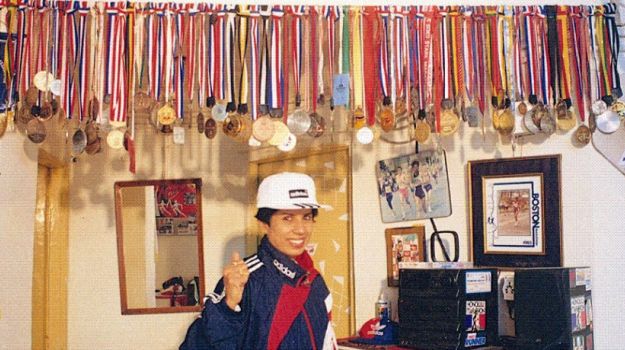
I’m not ashamed to admit that for many years, most of my fitness information came from a VHS series by MTV called ‘‘The Grind Workout.’’An incredibly ripped Eric Nies — a former cast member of ‘‘The Real World’’ known for tearing his shirt off with alarming regularity — would lead an attractive crew through a routine of stretches and aerobics for 45 minutes in an ‘‘abandoned’’ lot covered with graffiti.
The series, of course, wasn’t really about working out. Yes, they did squats and uppercuts to techno music. But it was more about the entertainment of exercise. Each tape featured a guest instructor who demonstrated complicated dance combinations, the kind that pop stars like Britney Spears and Janet Jackson performed onstage and in their videos. Half the fun was watching Nies and his crew fall effortlessly in line with the synchronized movements. Occasionally, the teachers would pause and deliver a brief lecture: about the importance of, say, a healthy heart rate or staying hydrated. I made note of it all from my perch on a sofa, usually lying down, working my way through a bag of chips and a bottle of soda. The contrast between the toned thighs, sculpted arms and washboard abs on-screen and my soft preteen figure felt like too large a gulf to ford.
It took me years to find a program that kept me in shape: Gyms felt intimidating, and women’s magazines seemed tailored for toning the bodies of already trim white women. We had nothing in common, including our so-called problem areas. I experimented with every kind of class possible — yoga, spin, Pilates, rowing — but it was all haphazard, cobbled together by trial and error.
But earlier this year, a friend introduced me to the Instagram account of a personal trainer named Massy Arias. Arias is a 28-year-old Dominican-American woman with a body rarely seen in an exercise program or a fitness magazine. She has tattoos, curly black hair and thick thighs that she seems to have no interest in trimming down. In other words, I saw echoes of my own figure in hers. I quickly became fascinated by her online presence. During a typical week, Arias posts three or four short videos of herself working out, generally at home or outside, using easily accessible props like medicine balls and resistance bands. She also posts photographs of her meals, along with the recipes, and photographs of herself that demonstrate the payoff of all her hard work.
Continue reading the main story
Continue reading the main story
Arias belongs to a growing coterie of personal trainers who are building empires on Instagram. The fitness universe on Instagram is almost incomprehensibly vast — there are hundreds of millions of photographs with hashtags like #fitness, #workout, #fitfam, #fitnessjourney or #fitlife, featuring people in various states of undress, lifting weights, making and drinking shakes, demonstrating techniques and documenting inches and pounds lost, all alongside messages about staying motivated to hit the gym and eat right. It’s as inspiring and vapid as anything else on social media — and somehow manages to invoke awe and envy at the same time. In a way, fitness Instagram is just the next iteration of a business model that began in the 1980s and 1990s, when workout gurus like Richard Simmons and Jane Fonda created their own empires by selling VHS workout tapes (and eventually workout DVDs) to people who wanted to learn to exercise from the comfort of their living rooms. Those products were marketed in health magazines, on daytime and nighttime talk shows and in infomercials. But as streaming-media sites like YouTube and Netflix matured, businesses built on the backs of older media dwindled. And as social-media sites like Instagram grew, people like Arias realized they could sidestep the traditional machinery that ruled the fitness world to tap into new audiences, especially those the fitness industry has often ignored.

Arias told me that she started working out as a holistic way to treat chronic depression. She documented her fitness journey online, which held her accountable and allowed others to participate remotely, if they wanted. After weeks of working out, she posted a photograph of her sculpted abdomen, which went viral. She gained several tens of thousands of followers overnight. ‘‘People started asking me how I did it, and how can they do it,’’ she said. She became certified as a personal trainer, so she could start teaching and dispensing advice, and began doing workout classes in Central Park. Eventually, she started posting short videos on Instagram, teaching people quick routines they could do at home. She began creating 30-day workout and meal programs that people could sign up for on her website; for a fee, they could get access to Arias and a digital community that was also working out that month. Her Instagram functions as a marketing tool, driving people to her website and paid services. And it works: Arias told me that between 1,000 and 2,000 people sign up each month to receive personalized workout advice. She also works with brands that want to reach her 2.2 million followers on Instagram to advertise, say, a supplement or active-wear company, and that advertising makes up about 20 percent of her income.
Arias has benefited from the fact that social media has become a place for people ill served by most traditional industries, and fitness is no different — it allowed people to more easily find trainers, lifestyles and information that were previously more difficult to access. As Jessamyn Stanley, a yoga teacher with a large following on Instagram, put it to me: ‘‘It’s about making something accessible by making it visible to lots of people.’’ Stanley said she was able to find an audience online that would have been hard to build offline: ‘‘There was a niche community of people waiting for a yoga book written by a queer, fat, black person. It was just about finding the means to reach them.’’ But as much as Stanley credits her successes to social media, she noted that the performativity and stylization popular on the internet can quickly get out of hand. ‘‘It can create molds and archetypes that become bigger than the activity itself,’’ she told me. She gave the example of an Instagram cliché: a handstand at sunset on a beach. ‘‘It’s so idealized, like, your life must be perfect if you can hold a balance posture on the beach,’’ she said. ‘‘But the actual practice of yoga isn’t about that at all. The image isn’t important. The practice is.’’
In a 2014 article for BuzzFeed, Katie J. M. Baker wrote about the complications of documenting a lifestyle online. She examined healthful-food blogging on Instagram and wondered about its relationship to disordered eating habits. ‘‘It’s impossible to tell whether these exquisite bowls are a product of calming ritual or unhealthy obsession (or both), or whether their creators are actually eating the artwork they profess is so delicious,’’ she writes. ‘‘But onlookers will always judge young women for what they choose or don’t choose.’’ Baker’s article reminds us that performance can pervert; Stanley told me that social media, for all of its benefits, is a place that can still replicate a lot of the same body-image pressures that the world at large has long put on people. Aspirational lifestyles are still that — aspirational. She also pointed out that what tends to get the most attention on social media still largely adheres to a ‘‘cis-het white male gaze,’’ meaning that the images that tend to trend are still ones that fit into traditional beauty standards.
But Stanley also told me that ultimately, she feels that social media’s ability to forcibly expand perspectives on lifestyles trumps the pressure it may induce among viewers who now feel they have new standards to live up to. Stanley and Arias have attracted followings in part because they play into certain eye-catching aesthetics: a full-figured woman and another whose physique is so toned and muscular it is irresistible click-bait. And they’ve managed to turn that into profit, becoming an entirely new class of fitness entrepreneur — one that perhaps never would have existed without the advent of social media. Both women have changed my relationship to fitness and my body: Although I am frequently the only woman of color in my real-world yoga and fitness classes, I can always turn to a screen and look at Stanley’s and Arias’s accounts to remind myself that bodies like ours have a place in this realm.










